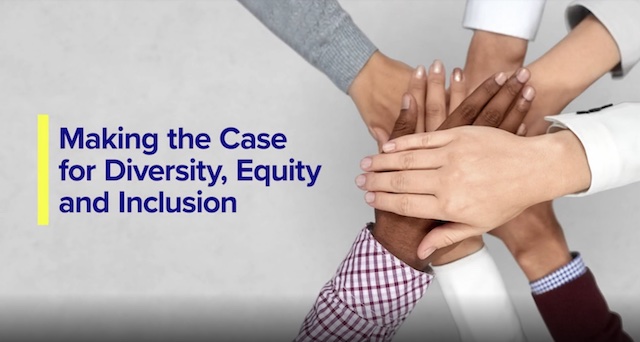What Is Diversity?
At its simplest, diversity refers to variety. In workplaces, diversity speaks to the variety of people employed by organizations – individuals of different races, cultures, age groups, ethnicities, educational and economic levels, religions, sexual orientations, physical and intellectual abilities, and other characteristics.
Despite the fact that the population of the U.S. (and beyond) is growing more diverse, many workplaces don’t reflect similar demographics. Research1 on diversity finds under-represented groups remain outnumbered by white employees across most organizational levels, making it difficult for diverse workers to advance into professional and leadership positions.
However, 76% of U.S. employees and job seekers view workforce diversity as an important factor when considering a potential employer, and a third say they wouldn’t apply for a job at an organization that lacked a diverse workforce.
Understanding the Definitions: Diversity, Equity, and Inclusion
In the wake of events in 2020 that highlighted social inequalities, greater attention has been focused on the idea of a diverse workplace. In turn, some organizations have expanded their approach to diversity by adding the concepts of inclusion and equity.
- For employers, Diversity refers to the goal of organizational workforces made up of employees from varied backgrounds, genders, cultures, races, ages, and other attributes. Diversity falls into two main categories:
– Visible diversity - anything that can be seen, such as race, gender, age, physical ability, or physical disability, etc.
– Invisible diversity - anything you cannot see, such as ethnicity, education level, religious beliefs, cognitive ability, etc. (One example of Invisible Diversity — Neurodiversity — is discussed in this podcast featuring topic expert Haley Moss.)
- Equity encompasses the notion that all of an organization’s employees are treated fairly and have the same barrier-free access to opportunities for development, career advancement, benefits, compensation, and other aspects of the employee value proposition. In other words, equity is about equal treatment in the workplace.
- At the heart of Inclusion is an organization’s commitment to fostering a sense of belonging. That means creating a workplace environment where everyone feels valued, respected, and encouraged to participate – to be a part of the team.
Consequently, employers may refer to their internal functions or initiatives as Diversity; Diversity and Inclusion (D&I, or in some cases, I&D); or Diversity, Equity, and Inclusion (DEI).
Why Diverse Workforces Matter
 For business enterprises, success is about bottom-line results that accomplish organizational missions and drive revenues and profitability. Widely cited and respected research2 by McKinsey & Company confirms a strong business case for diverse workplaces. Since 2014, data consistently (and increasingly) documents better financial performance by companies whose leaders reflect:
For business enterprises, success is about bottom-line results that accomplish organizational missions and drive revenues and profitability. Widely cited and respected research2 by McKinsey & Company confirms a strong business case for diverse workplaces. Since 2014, data consistently (and increasingly) documents better financial performance by companies whose leaders reflect:
- gender diversity (25% more likely to report greater profitability)
- ethnic diversity (36% more likely to report greater profitability)
Watch this short video to learn more
Other research3 has found that diverse organizations are far better (70%) at entering new markets, attracting new talent, making decisions (87%), innovating, and reaching their financial goals (120%). Given such strong support for business outcomes, it isn’t surprising that 69% of executives4 say that diversity and inclusion is important.
What is Diversity Training?
 Unfortunately, diversity, equity, and inclusion don’t happen spontaneously in organizations. Individuals at all levels may need specialized training to help them overcome their natural tendencies toward bias (unfair prejudice against someone or something). Often, such tendencies are so strong that training must be supplemented with structured opportunities to practice new behaviors.
Unfortunately, diversity, equity, and inclusion don’t happen spontaneously in organizations. Individuals at all levels may need specialized training to help them overcome their natural tendencies toward bias (unfair prejudice against someone or something). Often, such tendencies are so strong that training must be supplemented with structured opportunities to practice new behaviors.
A third of recently surveyed5 HR decision-makers revealed that DE&I is an immediate priority for their organizations, and two-thirds say that new skills and competencies for their workforces is of top importance, too. Diversity training as part of that skilling priority can help ensure that organizations educate their employees in all aspects of diversity, equity, and inclusion to address bias, reduce discrimination, and promote respectful and effective interactions in the workplace.
The best diversity training programs promote greater awareness of diversity and related issues, but also drive development of the skills employees need to communicate and work effectively with diverse colleagues. Instruction also promotes respectful workplaces by teaching employees to recognize discrimination and bias, and intervene constructively to expose and stop it.
In many organizations, diversity training is a requirement for compliance with state and/or federal anti-discrimination laws.

When organizations avoid addressing bias— even if employees aren’t aware that they’re behaving or speaking inappropriately or don’t intend to do so (unconscious bias) — legal liabilities can result.
Diverse individuals who experience discrimination because of their gender, age, race, physical or intellectual abilities, or other traits may file legal actions through the U.S. Equal Employment Opportunity Commission6 – the federal government agency responsible for enforcing federal laws against discrimination.
Examples of Diversity in the Workplace
 To see examples of diversity and inclusion in the workplace—explore Media Partners’ award-winning diversity training programs.
To see examples of diversity and inclusion in the workplace—explore Media Partners’ award-winning diversity training programs.
Getting Real About Bias, Diversity and Inclusion, and Harassment
Overcoming Unconscious Bias




